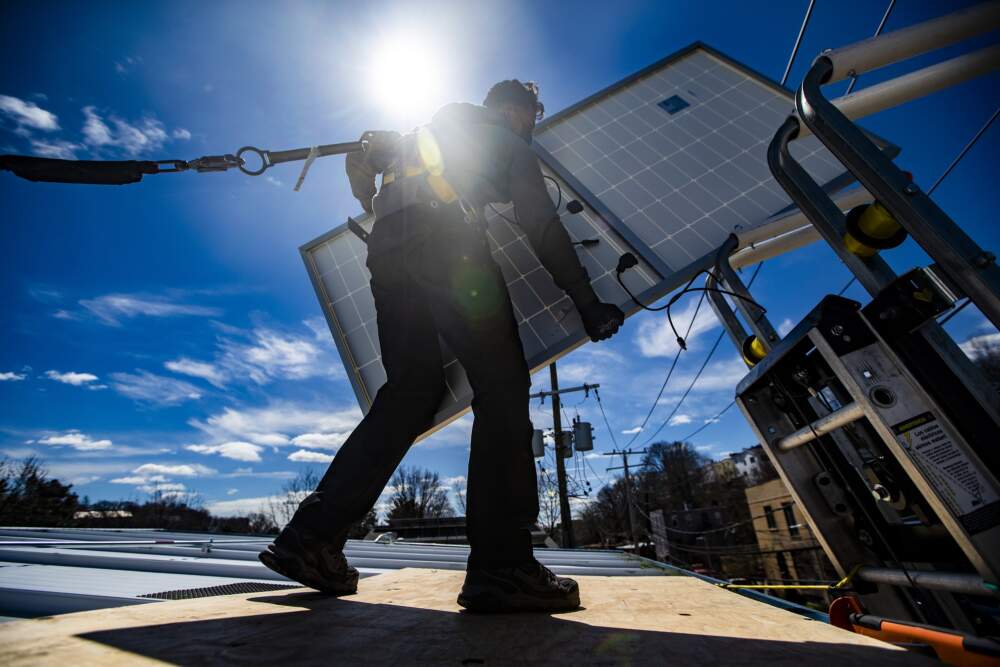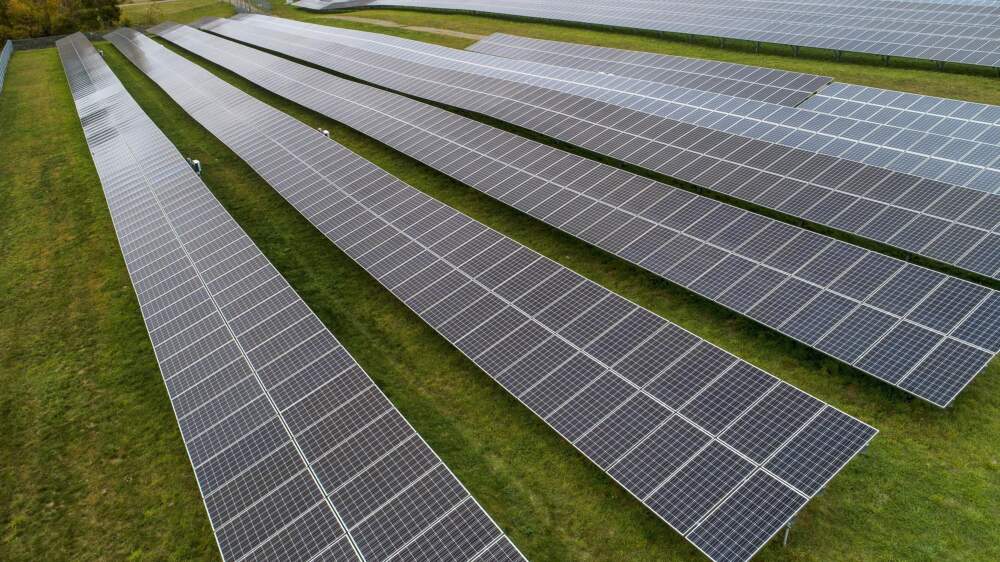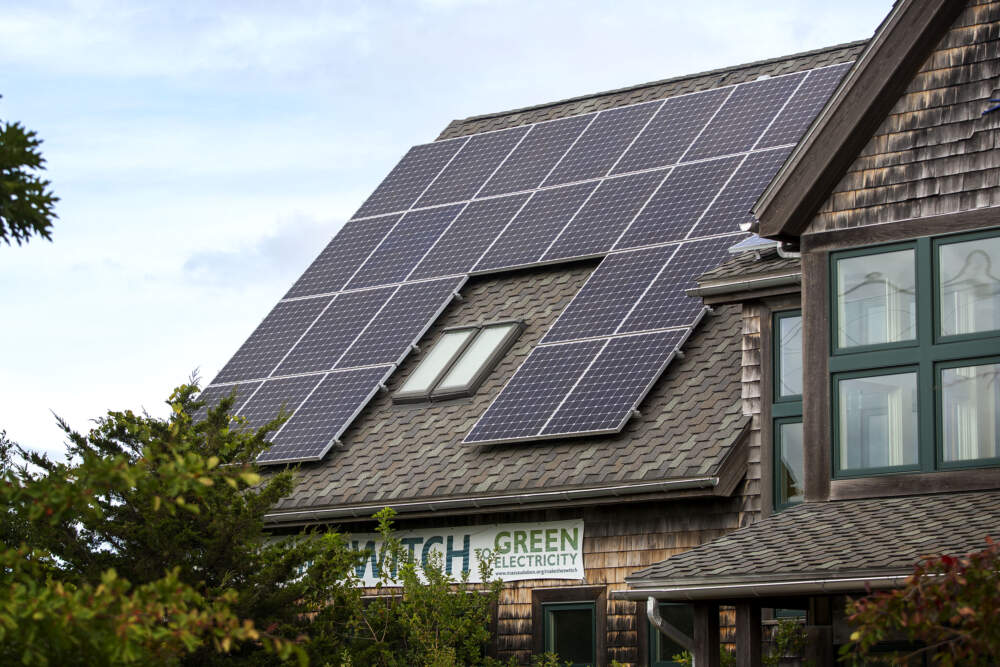Advertisement
Mass. can expand solar without chopping so much forest, report says

If you look at it one way, Massachusetts is a solar-power success story. The amount of large-scale solar in Massachusetts has grown from nearly nothing in 2008 to about 20% of the electricity generated in-state today. Massachusetts now produces about 60% of New England's solar power, and ranks 11th in the nation for the amount of electricity generated from the sun.
But this boom has come at a cost: more than half of solar farms built in the state during the last decade required clear-cutting forest; another 16% covered workable farmland. The destruction of forests and farms has led to considerable opposition to solar farms in Massachusetts, with people in towns from Amherst to Wareham organizing against solar development.
And damaging or destroying "working lands" like forest and farmland has environmental consequences as well: losses of wildlife habitat, stormwater drainage, and carbon storage. A new analysis from Harvard Forest and Mass Audubon finds that the forest loss alone resulted in more than 500,000 metric tons of CO2 emissions overall — the same as the annual emissions from 112,000 passenger cars.
But that same analysis argues that it doesn't need to be this way. Report authors say that Massachusetts could meet its ambitious goals for solar power — around 30 gigawatts of solar capacity by 2050, up from about 4 gigawatts today — while preserving the most valuable land.

"We can do the solar that we need, and we can hold on to a lot of the nature and working lands," said Michelle Manion, vice president of policy and advocacy at Mass Audubon and a co-author of the new analysis. "We can have both."
But doing so will require changes in state incentives and planning efforts to encourage more solar on rooftops and covered parking lots, and more ground-mounted solar on smaller patches of already-developed or degraded land, according to the report.
Another suggestion: more solar panels in giant suburban backyards. "A large residential lot that's already cleared — that's a better place for solar than clearing a bunch of forest," said Jonathan Thompson, senior ecologist at Harvard Forest and co-author of the report.
The report also points out that a focus on smaller ground-mounted sites could help address the biggest bottleneck for solar in Massachusetts: connecting a project to the electric grid. Building a large solar project often requires upgrading electric transmission and distribution infrastructure, which can be time-consuming, costly and controversial. At least two gigawatts of solar projects in Massachusetts are currently stalled awaiting grid connection, said Manion. Smaller projects need less grid capacity, and nationally have been able to go online quicker.
Advertisement
These findings echo those of a recent study from the state's Department of Energy Resources, which estimated that there’s more than enough suitable land (and rooftops) to meet the state's goals without compromising sensitive environmental areas, farmland or forest.
There's widespread public support for building more renewable energy while preserving nature. A recent state survey found that over 85% of state residents believe that solar should be built on rooftops, parking lots, landfills and other developed areas, rather than on cleared forests and productive farmland.
But industry experts say it may not be so easy.

For one thing, most of best sites are gone. Massachusetts leads the country in solar-covered-landfills, but that means there's few left for solar development.
"Most of the viable landfill and brownfield sites in Massachusetts have been explored and developed," said Andrew Toomajian, a business development manager at SunBug Solar. "It's not a completely saturated market, but it's not a spot where we have a ton of undeveloped sites for solar at this point."
And while putting solar panels on covered parking lots seems like a no-brainer, it's not easy. After all, parking lots aren't designed to catch sunlight — the roofs may be angled the wrong way or have supports too weak to hold the panels and electric gear. Another problem: all those people driving around.
"You need to have protection around the posts so that people don't drive into them, you need lighting for security, and it all just adds up," said Lawrence Cook, who constructs solar farms for Pure Sky Energy, which has 12 solar sites in Massachusetts. "And it is not just a little bit more, it is significantly more, almost prohibitively so in most cases."
Phil Coupe, one of the co-founders of Maine-based ReVision Energy, agreed that adding solar panels to covered parking lots can be prohibitively expensive — his company has only done about ten such projects.
However, he said that ReVision has been able to site about 100 megawatts-worth of solar projects on degraded land in New England — such as highway medians and gravel pits — without any hit to their bottom line.
“We haven't felt any kind of diminishment in our business opportunities by sticking to these types of opportunities and trying at every turn to avoid cutting down any trees,” he said. “Cutting down forests to site solar arrays is analogous to taking a perfectly healthy human and taking out their lungs and putting them on a ventilator. Nobody in their right mind would ever argue that that's a great thing to do.”
The Harvard Forest-Mass Audubon report acknowledges that putting commercial solar projects in smaller, more complicated sites will cost more. The report estimates that their mid-range land-preservation scenario will cost about $900 million more than a business-as-usual plan. But it argues that when the land's carbon storage value is taken into account — an estimated $940-$980 million — preserving nature is actually a bargain.
"Forests directly absorb carbon from the atmosphere — that's what photosynthesis is. They are a technology for carbon removal," Harvard Forest's Thompson said. "But we also need to remember that forests are far more than buckets of carbon. They are providers of clean air and clean water. They are where we recreate. They're where we find solace and they are home for biodiversity."
How to value these benefits remains a policy puzzle. The report authors suggest that the state could pay landowners more to keep land forested, or require developers to pay for lost carbon and biodiversity if they chop forest down.
The state has already tweaked its incentive program to push developers in this direction. And the plan is working, to some extent. Clark University geographer John Rogan, who uses satellite images to map solar placement in Massachusetts, found that solar developed after 2019 was predominantly along major roads, avoiding clearcutting forests.
Department of Energy Resources Commissioner Elizabeth Mahony says her office is reviewing state incentives to make sure they align with state goals and the current costs of solar development. She said the review may lead to proposed changes in the state's solar incentive program, or a proposal for new programs, as early as 2024.
"We know that we have big targets under our clean energy and climate plan. And that's going to require some action pretty soon," said Mahony. "However, how we are preserving our forest is of concern for this administration as well."
"We have a both-and here. Let's just be thoughtful and intentional about how we can seize both opportunities," said Mass Audubon's Manion. "If we can do this in a state like Massachusetts, a lot of other states and regions will look to our solution."
This segment aired on October 3, 2023.
